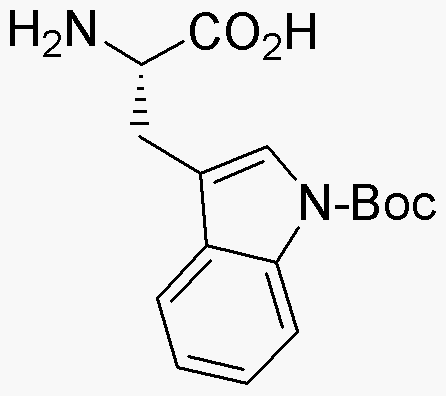Nin-Boc-L-tryptophan is widely utilized in research focused on:
- Peptide Synthesis: This compound serves as a key building block in the synthesis of peptides, particularly in the pharmaceutical industry, where it helps create biologically active compounds.
- Drug Development: It is used in the development of new drugs targeting neurological disorders, leveraging its tryptophan structure to influence serotonin pathways.
- Bioconjugation: Researchers employ Nin-Boc-L-tryptophan in bioconjugation processes, attaching it to various biomolecules to enhance their therapeutic properties.
- Protein Engineering: This chemical is valuable in protein engineering, allowing scientists to modify proteins for improved stability and function in therapeutic applications.
- Research on Tryptophan Metabolism: It aids in studies exploring tryptophan metabolism and its implications in mental health, providing insights into dietary impacts on mood and behavior.
General Information
Properties
Safety and Regulations
Applications
Nin-Boc-L-tryptophan is widely utilized in research focused on:
- Peptide Synthesis: This compound serves as a key building block in the synthesis of peptides, particularly in the pharmaceutical industry, where it helps create biologically active compounds.
- Drug Development: It is used in the development of new drugs targeting neurological disorders, leveraging its tryptophan structure to influence serotonin pathways.
- Bioconjugation: Researchers employ Nin-Boc-L-tryptophan in bioconjugation processes, attaching it to various biomolecules to enhance their therapeutic properties.
- Protein Engineering: This chemical is valuable in protein engineering, allowing scientists to modify proteins for improved stability and function in therapeutic applications.
- Research on Tryptophan Metabolism: It aids in studies exploring tryptophan metabolism and its implications in mental health, providing insights into dietary impacts on mood and behavior.
Documents
Safety Data Sheets (SDS)
The SDS provides comprehensive safety information on handling, storage, and disposal of the product.
Product Specification (PS)
The PS provides a comprehensive breakdown of the product’s properties, including chemical composition, physical state, purity, and storage requirements. It also details acceptable quality ranges and the product's intended applications.
Certificates of Analysis (COA)
Search for Certificates of Analysis (COA) by entering the products Lot Number. Lot and Batch Numbers can be found on a product’s label following the words ‘Lot’ or ‘Batch’.
*Catalog Number
*Lot Number
Certificates Of Origin (COO)
This COO confirms the country where the product was manufactured, and also details the materials and components used in it and whether it is derived from natural, synthetic, or other specific sources. This certificate may be required for customs, trade, and regulatory compliance.
*Catalog Number
*Lot Number
Safety Data Sheets (SDS)
The SDS provides comprehensive safety information on handling, storage, and disposal of the product.
DownloadProduct Specification (PS)
The PS provides a comprehensive breakdown of the product’s properties, including chemical composition, physical state, purity, and storage requirements. It also details acceptable quality ranges and the product's intended applications.
DownloadCertificates of Analysis (COA)
Search for Certificates of Analysis (COA) by entering the products Lot Number. Lot and Batch Numbers can be found on a product’s label following the words ‘Lot’ or ‘Batch’.
*Catalog Number
*Lot Number
Certificates Of Origin (COO)
This COO confirms the country where the product was manufactured, and also details the materials and components used in it and whether it is derived from natural, synthetic, or other specific sources. This certificate may be required for customs, trade, and regulatory compliance.


